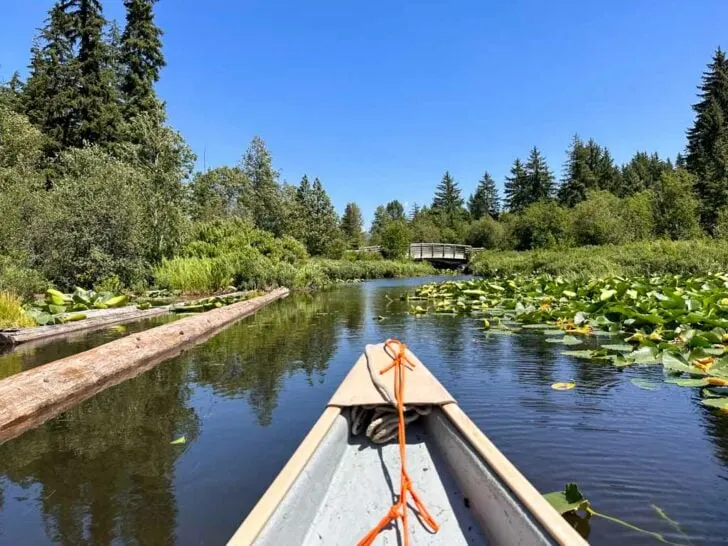The River of Golden Dreams is one of the best things to do in Whistler in the summer. It’s often described as a natural lazy river that winds its way between two lakes in the Whistler Valley.
I live in nearby Squamish so I have paddled the River of Golden Dreams both in my own canoe and in a rented kayak. But it’s easy for visitors to enjoy it too since you can take a tour or rent a canoe or kayak (which I’ve done and think is lots of fun). It’s a gorgeous trip with views of the mountains and lots of big trees and flowering huckleberry bushes.
In this guide to the River of Golden Dreams, I’ve got everything you need to know to plan a trip. It includes:
- FAQ: How long does it take? When to go? And lots more.
- Map: A custom map showing all the important spots
- Padding Directions: Step-by-step instructions for the whole trip
- How to Get There: Bus and driving directions plus info on how to get back from the finishing point
- What to Bring: A packing checklist of what you’ll want to bring and wear.
This is a sensitive wilderness area. Learn how to Leave No Trace to keep the wilderness wild. Make sure you are prepared by bringing the 10 Essentials. Get ready for adventure with this checklist of things to do before every hike.
Hey there: Some of the links in this post are affiliate links, which means I earn a small commission at no cost to you. Thanks for your support. -Taryn
River of Golden Dreams FAQ
Where is the River of Golden Dreams?
The River of Golden Dreams is a quiet section of Alta Creek that makes a natural lazy river as it flows between Alta Lake and Green Lake in the heart of the Whistler Valley.
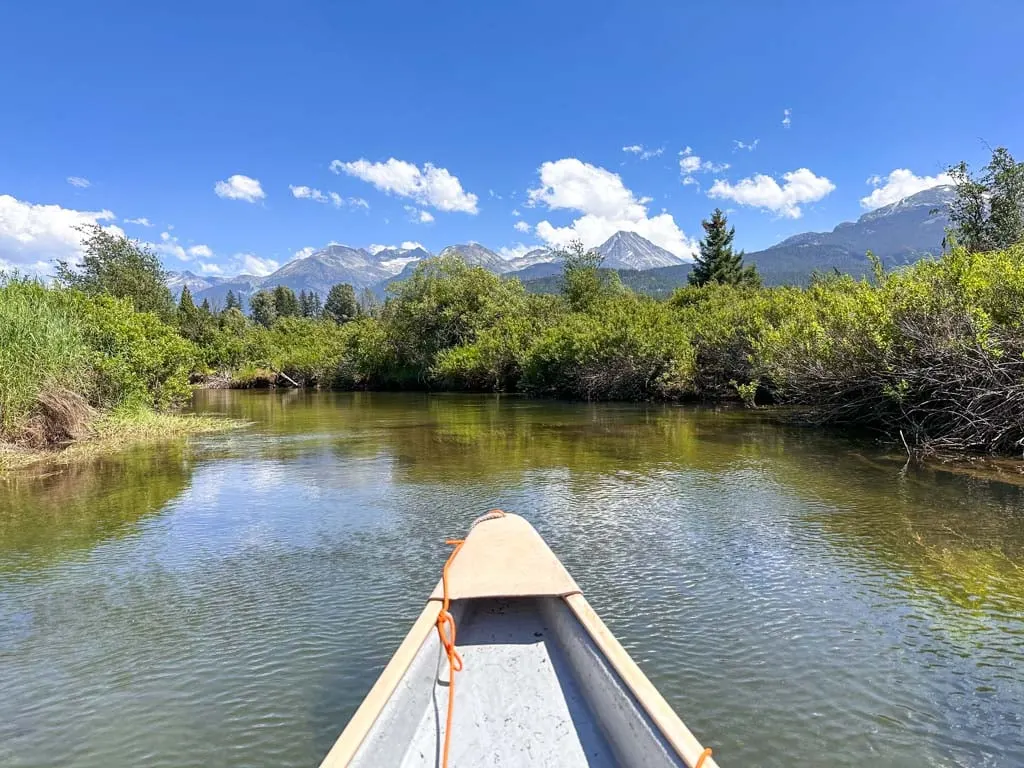
How long does it take to paddle the River of Golden Dreams?
The entire route is about 6.5 km long. Plan to spend about 2-3 hours paddling.
When is the best time to paddle the River of Golden Dreams?
July to mid-August has the best water conditions. At that time of year, the river isn’t so fast that you need expert paddling skills or so slow that there isn’t enough water.
Experienced paddlers can tackle the river from May to early July if they are comfortable handling fast-moving water with lots of sharp turns. There is also a portage at this time of year due to low bridge clearance.
After mid-August, water levels are low and parts of the river are very dry. This means that you will have to portage a dry section that is about 600 m long. You may also have to lift your canoe over several beaver dams. See the paddling route description below for more details.
The river is too high and dangerous to paddle in the spring (March and April) and fall (October and November). It is frozen in the winter (December, January, and February).
How much paddling experience do you need for the River of Golden Dreams? Can you just float down the lazy river?
While it is billed as a lazy river, you do have to do a bit of paddling to steer. If you don’t, you’ll get stuck in the bushes on the sides or even dumped from your boat in the faster-moving bits. But there are lots of parts where you can just chill and let the current carry you along.
The River of Golden Dreams is fairly easy as far as moving water goes, but it does require some experience and knowledge of paddling techniques. Paddling on a moving river is a bit different (and more challenging) than paddling on a lake.
You don’t need any paddling experience if you go with a guided tour. They will help you navigate and teach you the best way to paddle.
If you have a little bit of paddling experience, you will be fine on your own as long as water conditions are good. In high water or low water, you need to be an experienced paddler.

Can you paddle the River of Golden Dreams self-guided? Or do you need to go with a tour?
If you have your own boat, you can paddle self-guided. You can also rent a boat and go self-guided. Your boat rental includes a shuttle back to the start. Keep in mind that if you rent a boat and need rescue, the rental companies will charge you a rescue fee. You can book a self-guided tour in advance or just show up to the rental shack and hope they still have boats available.
If you’re not sure of your skills, take a tour. Tours includes boat rental, shuttle, instruction, and info along the way about plants, animals, and Whistler’s history. And this tour includes transportation to and from Whistler village. If you are a beginner, I recommend taking a tour as it can be tough to turn in the river if you don’t have some paddling skills.
How much does the River of Golden Dreams cost?
It’s free to paddle if you have your own boat. If you need to rent a canoe or kayak, it’s about $130 for boat rental and shuttle. Or you can go on a guided tour for about $165.
What kind of boat do you need for the River of Golden Dreams?
Canoes and kayaks work best as they are durable, stable, and easy to steer. I’ve done the River of Golden Dreams in both a canoe and a kayak.
Kayaks are easier to paddle and can feel more stable since you sit lower in the water. But they are harder to get in and out of if you need to portage or navigate beaver dams. You’ll also get a LOT wetter if you kayak since the paddle drips water in the boat. And if you get in and out with wet feet, you’ll drip more water inside. You sit on the bottom of the boat, so you are almost guaranteed a wet butt.
Canoes require a bit more skill to paddle, especially if you sit in the back, which is the steering position. However, it’s easy to learn if you take a guided tour. Canoes are easier to get in and out of and easier to portage. You also sit higher in the boat so you stay drier.
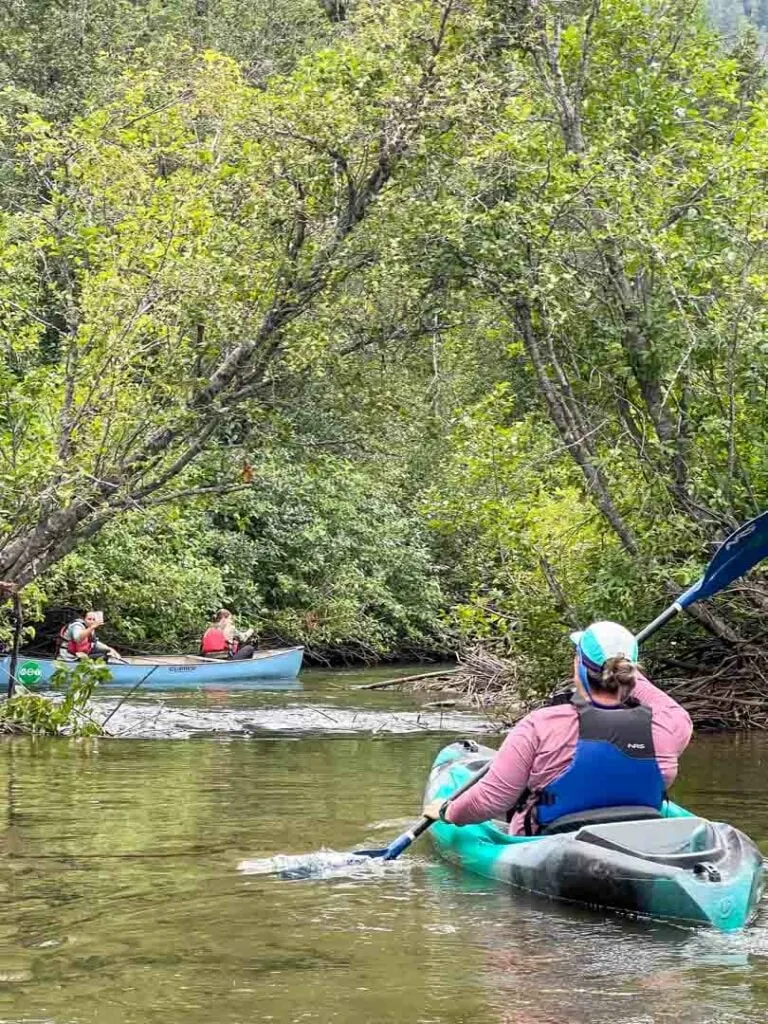
Paddleboards can also be ok on a warm day if you are ok with getting wet… because you will get wet. But use caution with inflatable SUPS. There can be lots of sharp sticks and logs, especially later in the season when the beaver dams are exposed.

You might see people taking inflatable air mattresses, pool toys, and big box store inflatable boats like Explorer 200s. Don’t do that. They pop easily, leaving you stranded in cold water. They also can be hard to fish out of the water when they pop, which pollutes the river.
Are there bears on the River of Golden Dreams?
Yes. Black bear sightings are common. If you see a bear, keep paddling and let them be. The bears just want to eat from the berry bushes – they aren’t interested in paddlers. Read my guide to bear safety for more tips.
What is the Indigenous context of the River of Golden Dreams?
The River of Golden Dreams is in the traditional territory of the Lil’wat and Skwxwu7mesh (Squamish) Nations. According to the oral tradition of these nations, they shared the Whistler Valley, using summer camps here to harvest plants and animals. To learn more about the Lil’wat and Skwxwu7mesh, visit the Squamish Lil’wat Cultural Centre.
River of Golden Dreams Maps
The River of Golden Dreams is fairly easy to navigate, but if you are on your own, you’ll need a map. I made a custom map in Gaia GPS for you. It shows you all the key points along the route. Click through to zoom in and explore.
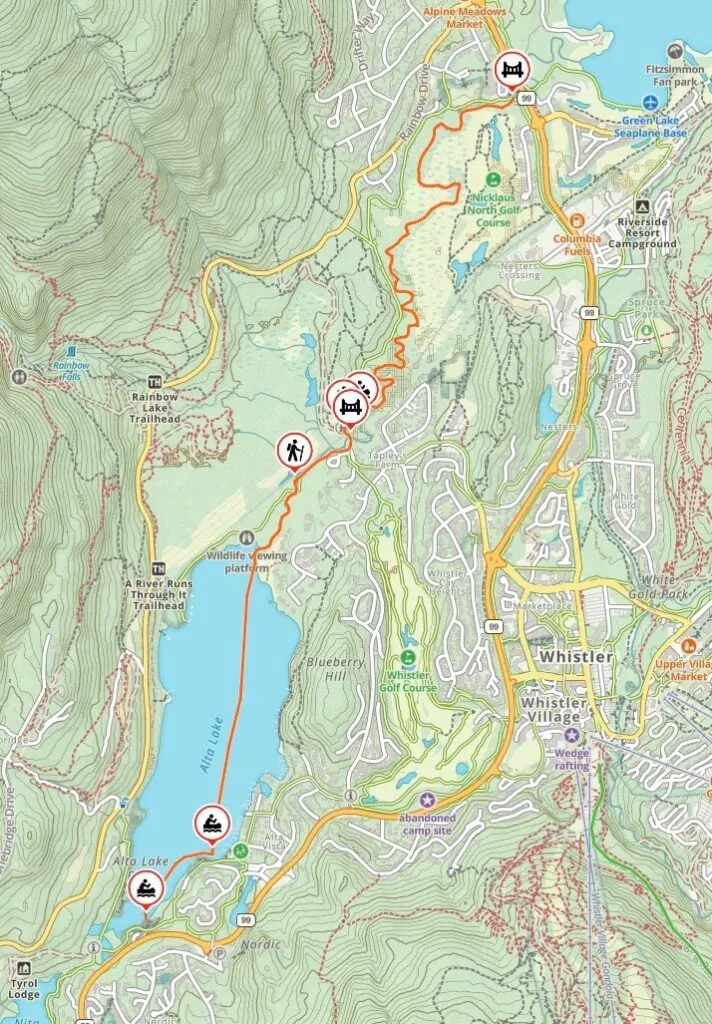
The Municipality of Whistler also has a good map that shows the key portage section. (Don’t worry, I’ll explain what it all means in the paddling directions section below.)
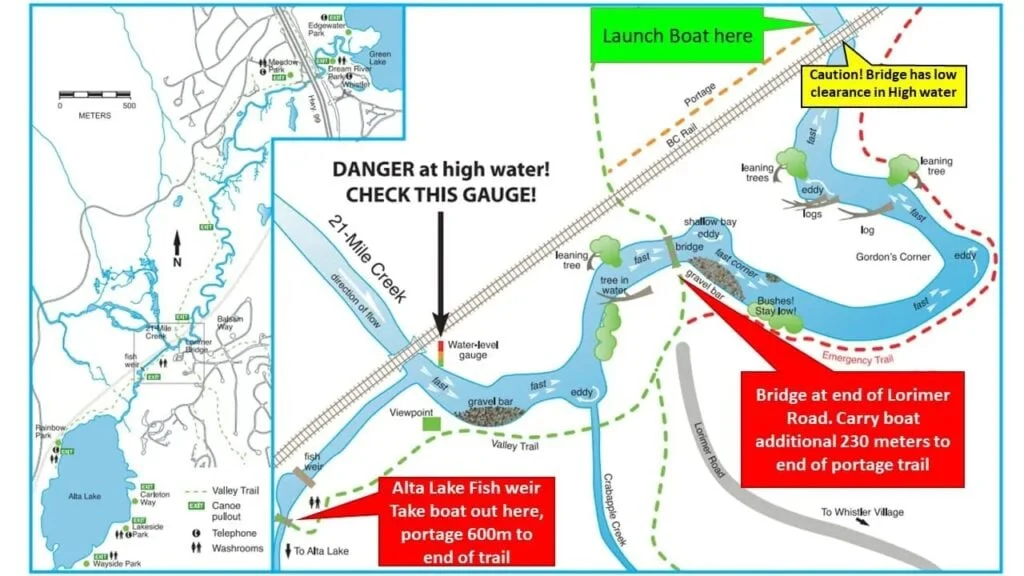
River of Golden Dreams Paddling Directions
Here’s my step-by-step directions for paddling the River of Golden Dreams. I’ve broken it up into several sections: Alta Lake and the Start, the Middle, Finishing, and Extending Your Trip.
Alta Lake and the Start of the River of Golden Dreams
To start the River of Golden Dreams you will launch from either Wayside Park or Lakeside Park on Alta Lake. Both of these parks have boat rentals and guided tours. (The How to Get There section below has more info on these locations.)
From there, you will paddle across Alta Lake for about 2 km which takes 20-30 minutes. If it is windy, this can be a bit challenging. At the north end of the lake, look for the River of Golden Dreams draining out of the lake.
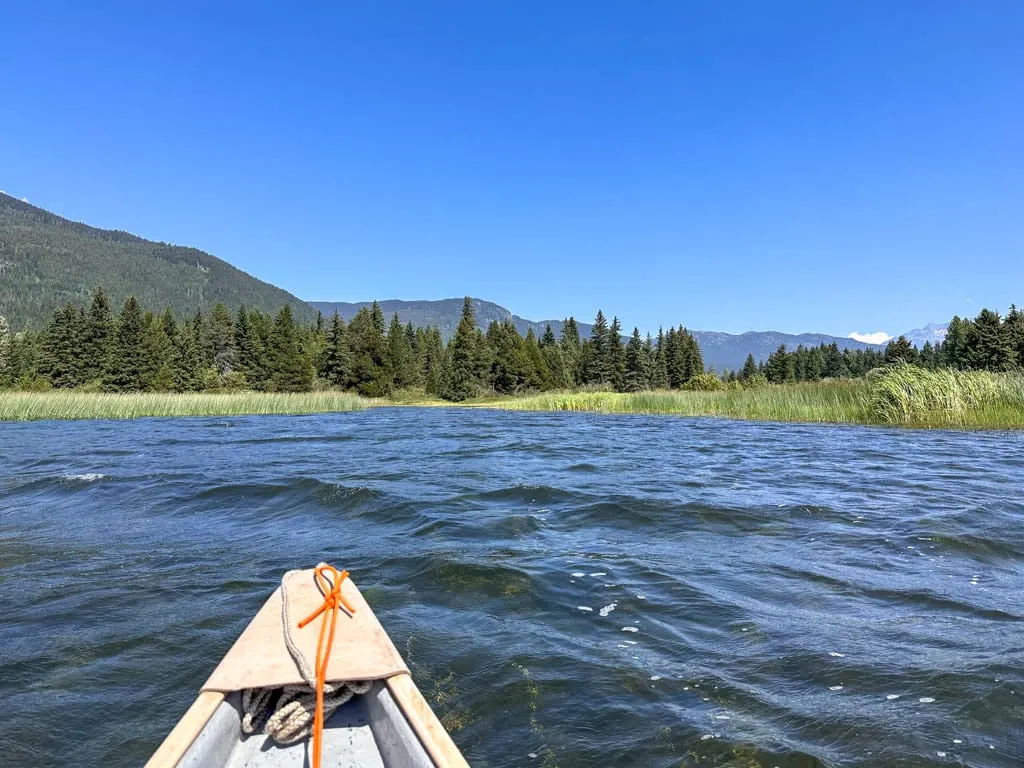
The first part is very narrow and choked with lily pads, but after a few minutes, it becomes a little wider.
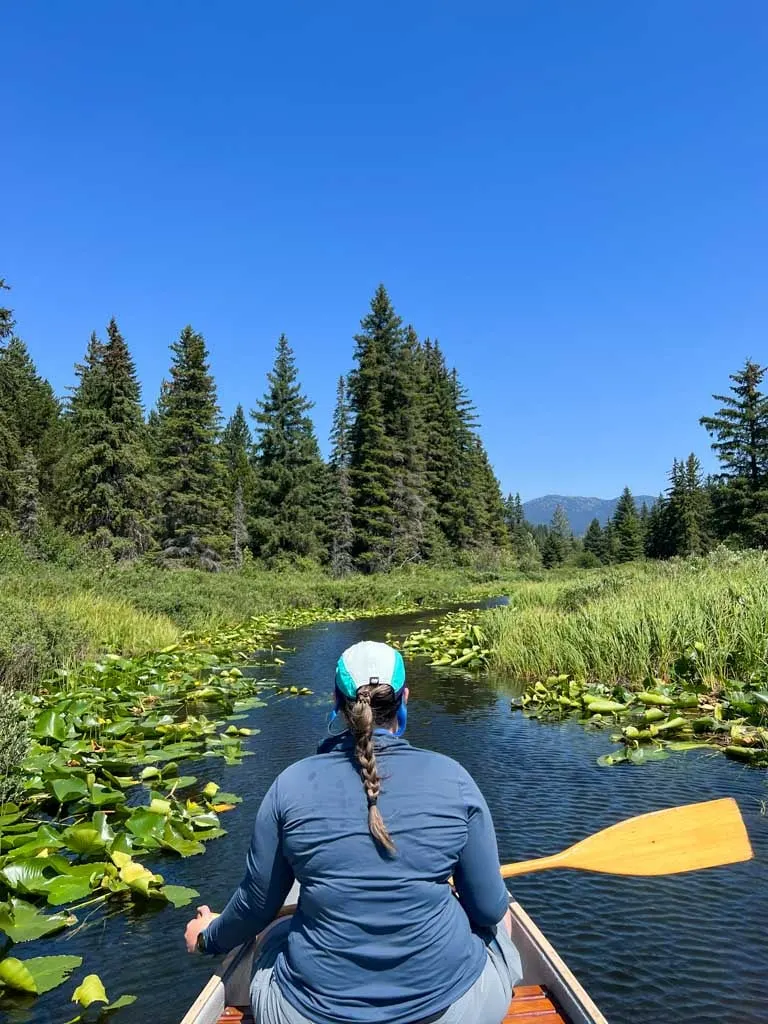
The Portage
After going around a few bends and going under a bridge, arrive at the Alta Lake fish weir, which has a dock. It’s a wooden stair-like structure that spans the width of the river. It should take about 15 minutes to get here from the end of the lake.
Past the weir, the river runs through a narrow ditch-like channel that is usually dry from mid-July until fall.
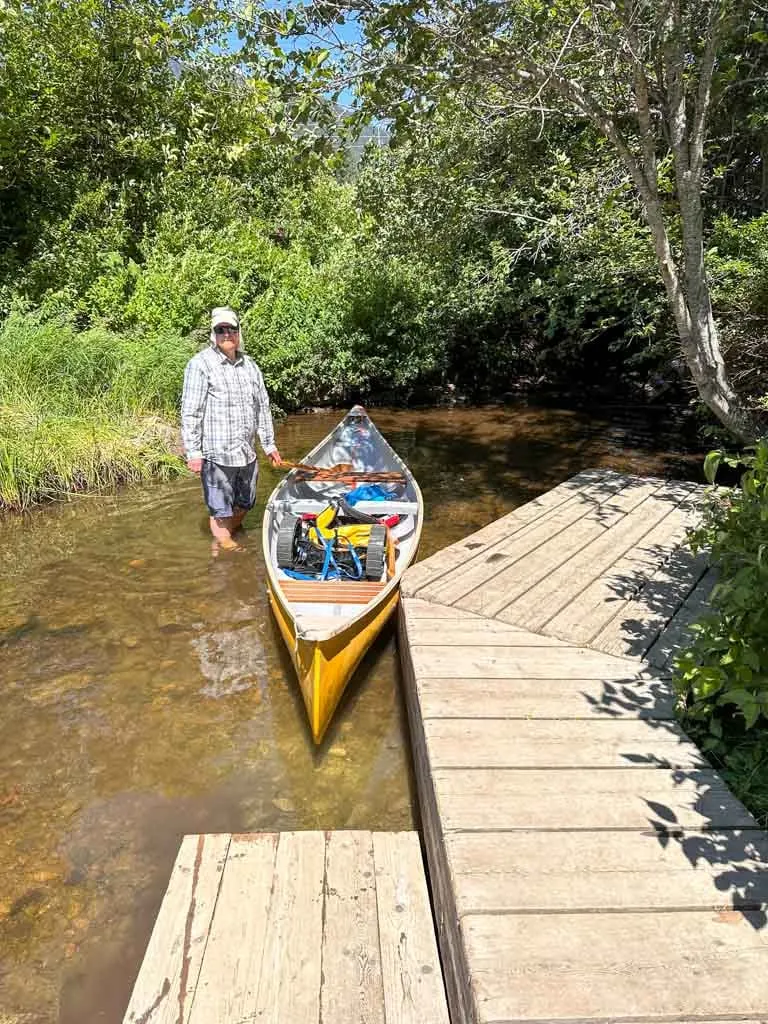
You need to get out of the river and start the portage here. Follow the path up the bank to the right. If you are renting a boat or are on a tour, there will be carts here you can use to wheel your canoe. Turn left and follow the paved valley trail for a few minutes (about 350m) to a bridge over the River of Golden Dreams.
If you are an experienced canoer and the water level is not too low or too high, you can put your boat back in the water here. This is one of the most beautiful sections of the river, with large old growth trees.
But this section can be dangerous at high water since the train bridge at the end is very low and you can get stuck underneath. As well, some of the fastest moving water is in this section, so this is where most paddlers capsize. And finally, if the water is too low, you won’t be able to paddle this section and instead will have to drag your boat through the gravel, which disturbs fish habitat.
I recommend just doing the portage instead. It’s only a few minutes further to walk and isn’t much hassle (you just miss one curve of the river).
To continue the portage, cross the bridge and then go through the yellow gates to follow the paved path across the train tracks. Go through the second set of yellow gates and look for the gravel path branching right. It is marked with a small portage sign. Turn right onto the gravel path and stay on it until it reaches the river again next to a train bridge.
Congratulations! You’ve finished the portage. The entire portage is about 600 m long and will take you 10-15 minutes.
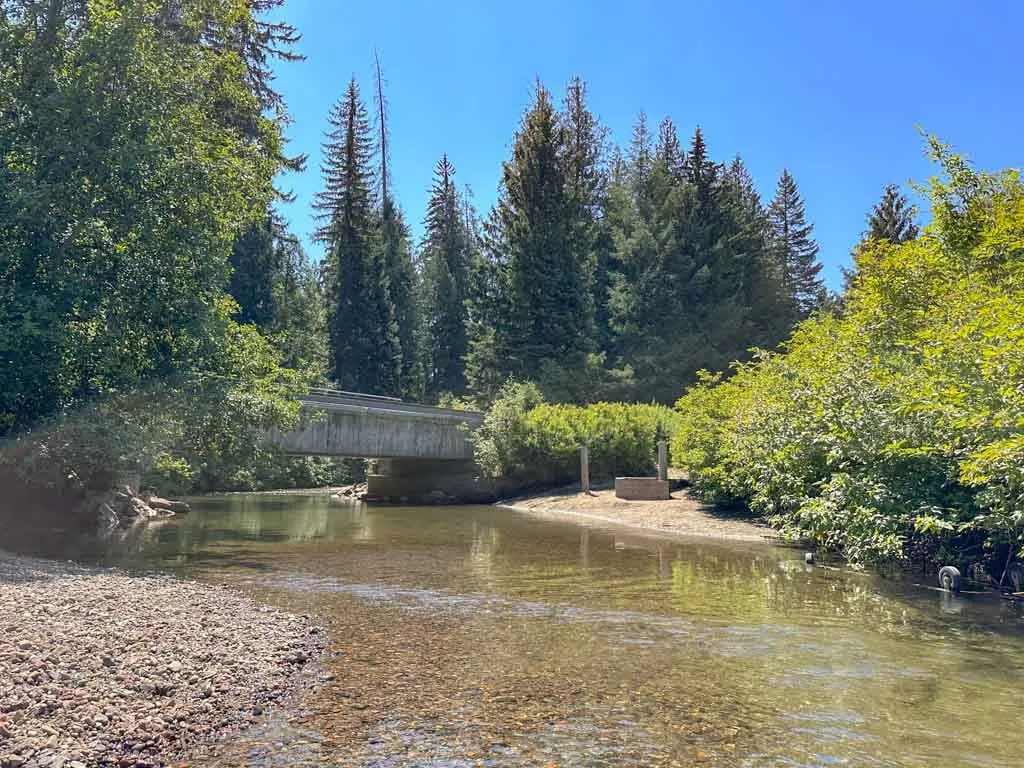
Paddling the Middle Section
After you get back in your boat after the portage, you’ll be in the middle section of the River of Golden Dreams. This is the best part of the trip. The river goes through about 30 curves as it snakes its way through the marshes of the valley.
In most places, the bushes on the sides of the river are high. The river is not far from homes, roads, and a golf course, but it will feel like you are in the middle of the wilderness since all you can see are birds, bushes, and trees. You can also see the mountains on all sides.

There are lots of types of plants, but the main ones are huckleberry bushes. In early summer they have pretty flowers, but later in the year, they have berries, a favourite food for bears. Be sure to keep an eye out for bears as you paddle. We got quite close to one before we even noticed it was there! But the bear was so focused on eating, that it didn’t care about us. Read my bear safety tips for more info.
Your trip will really depend on the river conditions. Sometimes when the water is low, there are lots of gravel bars to navigate. You might also encounter fallen trees or branches growing into the channel that you will have to paddle around.
Beaver dams can also impact your trip. If the water is low and the beavers have been busy, there will be lots of dams. Some dams have breaks in them so you can paddle through. But others will be high enough that you can’t paddle over them. Instead, you’ll need to get out of your canoe and lift it over. Be careful as the water can be really deep next to the dam!
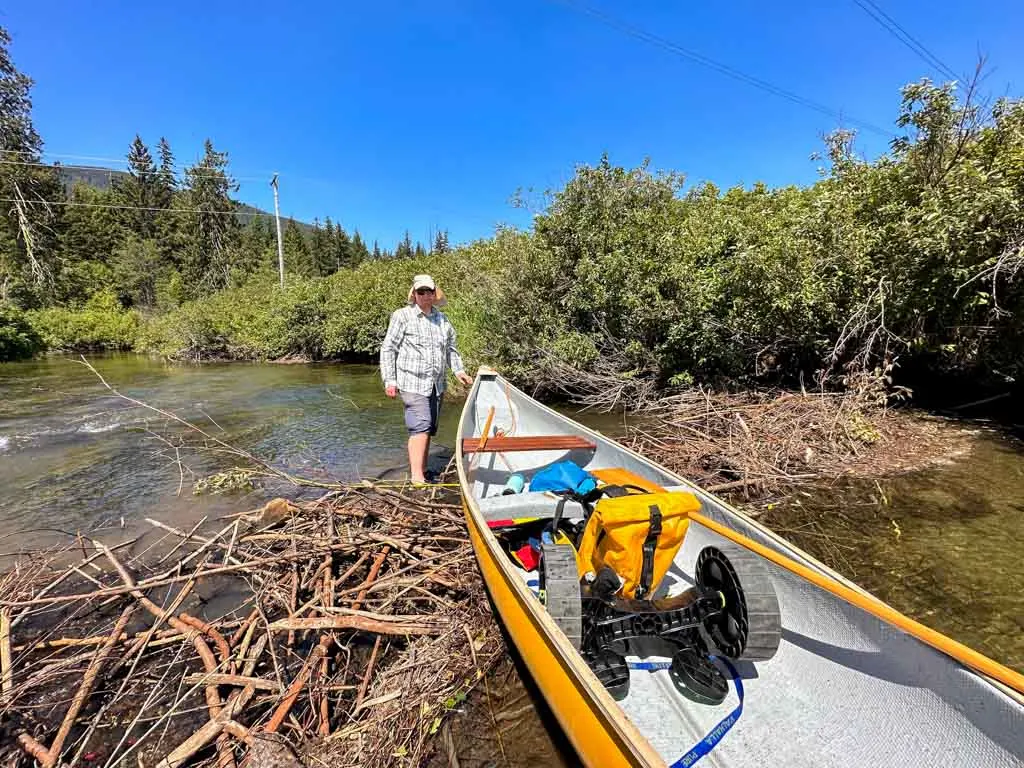
Ask your tour guide or the rental shop about river conditions before your trip so you know what to expect. If you are paddling your own boat, it’s worth asking about conditions at the rental shop before you go. They are usually happy to help.
Finishing the River of Golden Dreams
As you get towards the end of your trip, you’ll see a park with a walking path on your left. This is Meadow Park. A few minutes later you will paddle underneath a footbridge. The Meadow Park dock is immediately after the bridge on your left.

Pull over at the dock and follow the path up the bank to the parking lot at the Meadow Park Sports Centre. If you are on a tour or rented a boat, this is where you catch the shuttle back to the start.
Extending Your Trip
If you want to paddle a little bit further, you can continue past the dock and follow the river under the highway bridge and then another footbridge. The river makes a few more sinuous curves before emptying into Green Lake.
Green Lake is the biggest lake in Whistler so it can get windy. It’s best to stay near shore. You can explore Green Lake, which has gorgeous views. If you’re really ambitious, paddle down to the northeast end to check out Parkhurst Ghost Town.
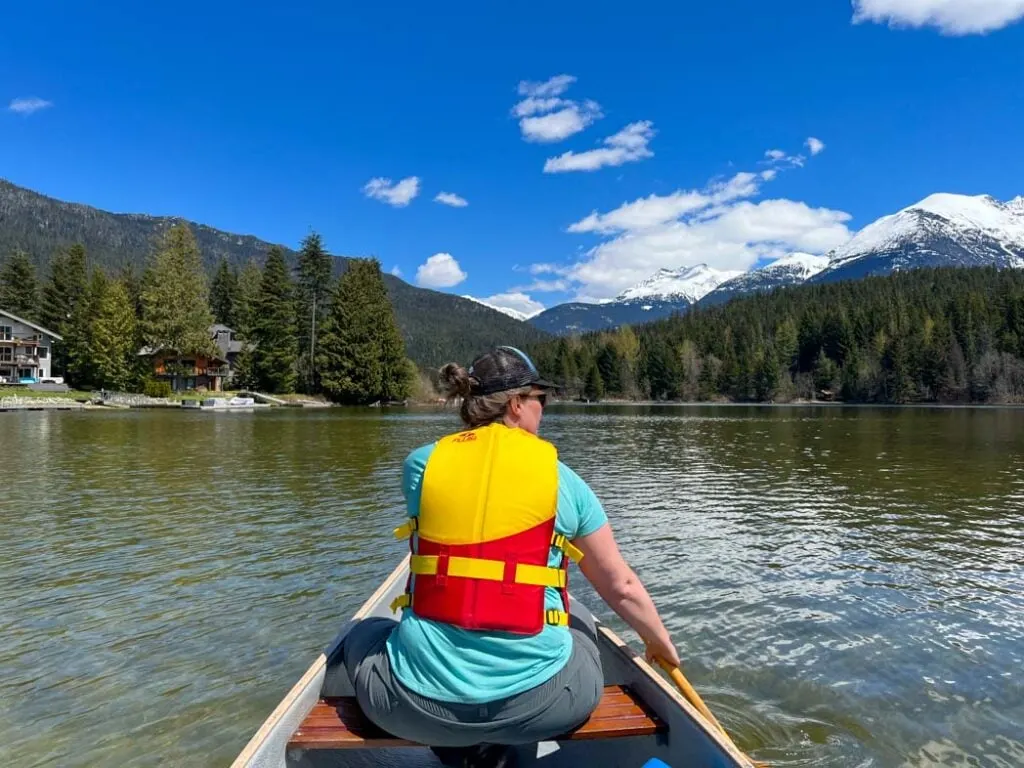
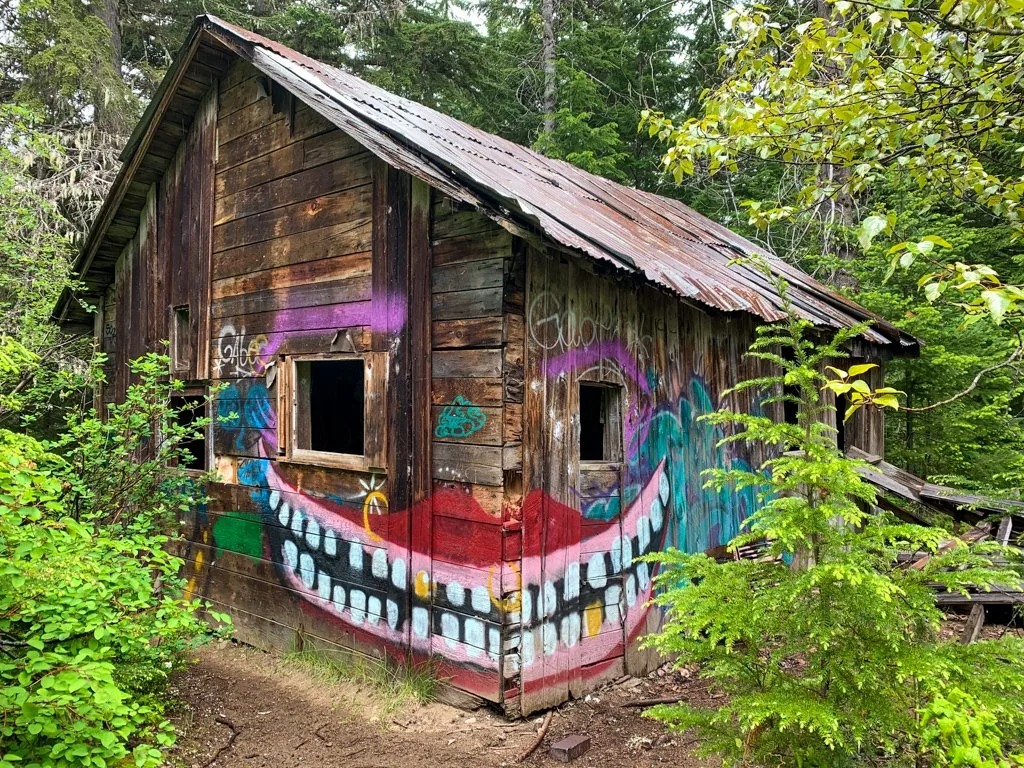
When you are done, head out of Green Lake by paddling back upstream along the River of Golden Dreams to the Meadow Park dock. Keep in mind that you will be paddling against the current, which will be much more challenging than the paddling you did going downstream!
How to Get to the River of Golden Dreams
The River of Golden Dreams starts at Alta Lake. If you have booked a guided trip or a self-guided trip including boat rental, Backroads Whistler tours start at Lakeside Park and Whistler Eco-Tours start at Wayside Park. You can arrange a shuttle to Alta Lake if book a tour.
If you have your own boat, you can also launch at Rainbow Park. I’ve got directions for all three below.
It’s worth keeping in mind that parking is very limited at any of the parks on Alta Lake. It can be impossible to get a parking spot on a summer weekend unless you arrive very early in the morning. You may want to consider walking or biking to the start. You can also take a taxi or the bus.
Wayside Park
Wayside is a small park near the south end of Alta Lake. It has a little bit of grass but not much beach. If you launch here, you will paddle almost the entire length of Alta Lake before starting the river section.
The Whistler Eco-Tours boat rental hut and dock are down the hill from the parking lot. There is a sloped path you can use. If you brought your own boat, you can launch from the dock.
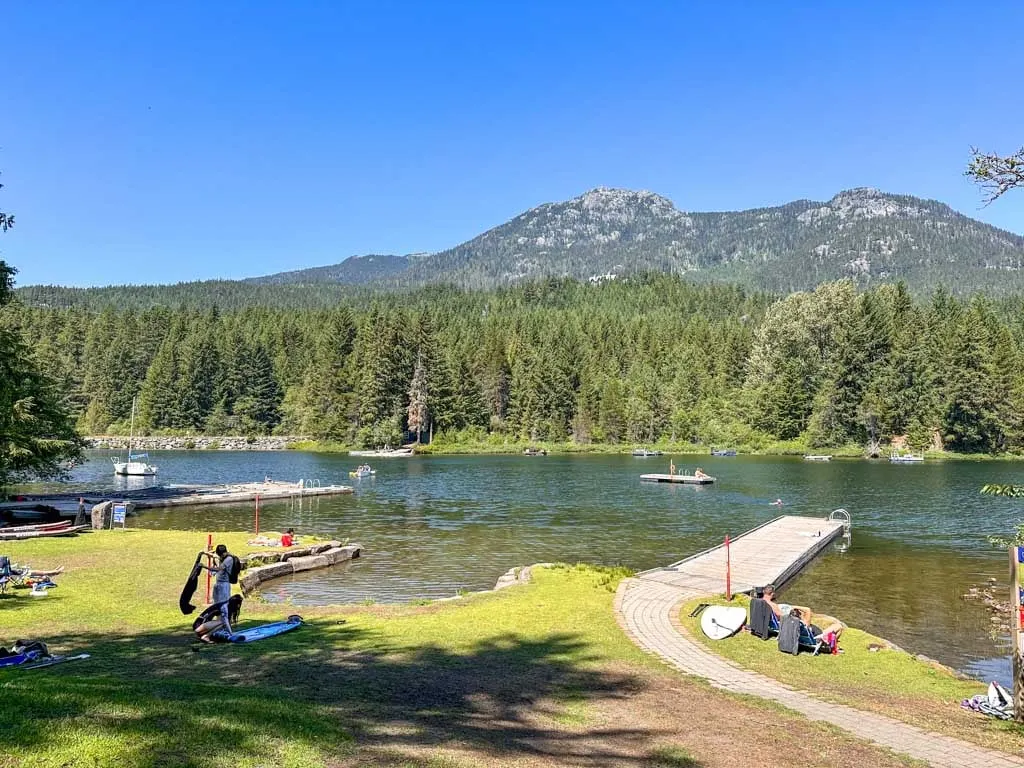
To drive here, head south from Whistler Village on Highway 99. After you go under the pedestrian overpass at the intersection with Nordic Drive, start watching for the small blue sign for Wayside Park. Turn right into the parking lot. It’s easy to miss! It has about 15 parking spots. There is no overflow parking. Click here for Google maps driving directions.
To get to Wayside Park by bus, take Bus 20 or Bus 21 from Village Gate to the stop on Nordice Drive. Then, use the pedestrian overpass to cross the highway and turn left onto the Valley Trail. Walk 5 minutes along the trail to the park. Click here for Google Maps bus directions.
You can also walk or bike to Wayside Park via the Valley Trail. It takes about 20 minutes to bike or 1 hour to walk the 4 km distance. Click here for Google Maps walking and biking directions. Whistler Eco-Tours offers a pedal and paddle combo tour that includes a guided bike ride from the Village to Wayside Park.

Lakeside Park
Lakeside Park occupies a large, flat grassy area on the east side of Alta Lake. If you start your trip here, you will paddle about 2/3 of Alta Lake before reaching the river.
Backroads Whistler starts their tours out of a kiosk in the centre of the park. If you brought your own boat, you can launch from the beach or the dock.
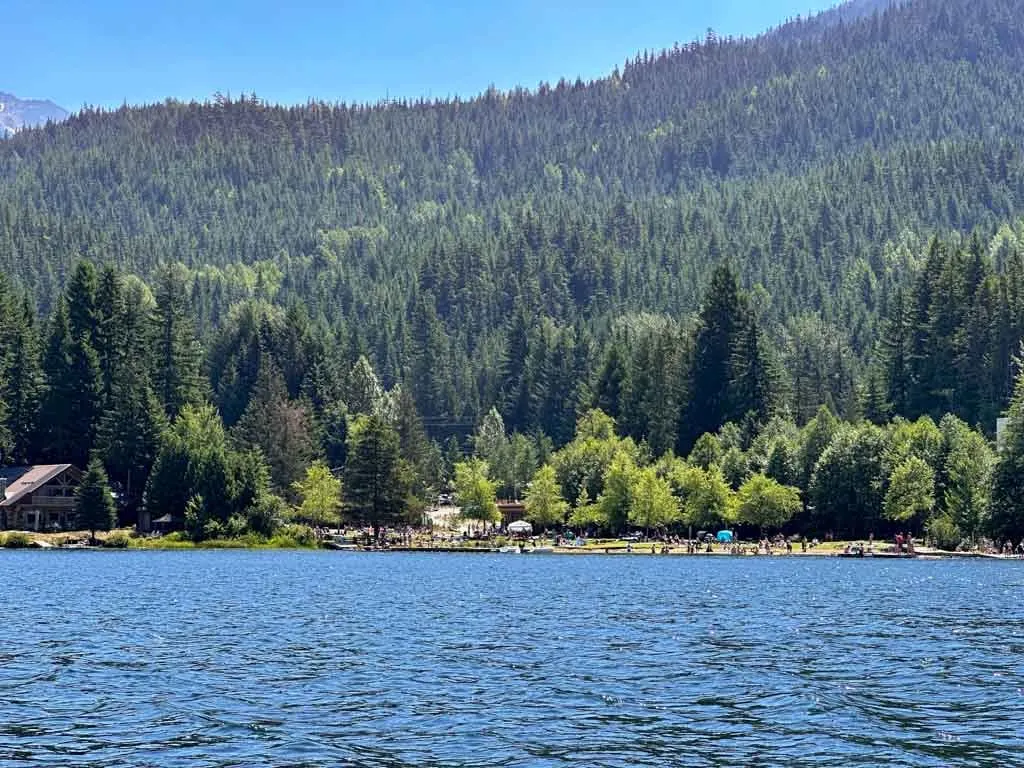
To drive here, head south from Whistler Village on Highway 99. Go straight through the traffic light at Blueberry Drive, then turn right onto Hillcrest Drive at the sign for the Alta Vista neighbourhood. Reach a Y-junction right away. Turn right onto Alpine Crescent to access the parking lot.
There is a little bit of overflow parking along Hillcrest Drive. Pay attention to signs to make sure you park legally. Click here for Google Maps driving directions.
You can also get here by bus. Take bus 10, 20, or 21 from Village Gate to the stop on the Sea to Sky Highway just before Hillcrest Drive. Then walk 5 minutes along Hillcrest into the park. Click here for Google Maps bus directions.
It’s easy to get to Lakeside Park by bike or on foot. It takes 10 minutes to bike or 40 minutes to walk the 3 km distance. Click here for Google Maps walking and biking directions.
Rainbow Park
Rainbow Park is the largest of the three parks on Alta Lake. It is close to the end of the lake, so you will be paddling in the river almost immediately. There are no tour or rental operators here so you will need to bring your own boat if you plan to launch from Rainbow Park.
To drive to Rainbow Park, head north on Highway 99. A few minutes later, turn left at the traffic light onto Alpine Way. A block later, turn left onto Rainbow Drive. Stay on this road (which becomes Alta Lake Road) for about 4 km, then watch for the entrance to the park and parking area on your left. There may also be some overflow parking on the gravel shoulder. Pay attention to signs to make sure you park legally. Click here for Google Maps driving directions.
How to Get Between the Start and Finish of the River of Golden Dreams
With a Tour or Rental
If you book a boat rental or guided tour for the River of Golden Dreams, the tour company will pick you up a the end of the River Golden Dreams at Meadow Park Sports Centre and give you a ride back to your starting point. They may also drop you off in the village if you request it.
I recently did the Whistler Eco-Tours pedal and paddle combo tour. We met in Whistler Village and rode rental bikes to Wayside Park. Next, we paddled the River of Golden Dreams. At the end of the paddle, the shuttle drive picked up our boats and delivered our bikes so we could bike back to the village. So far this is my favourite way to do the River of Golden Dreams since you get to experience biking in the forest too.
With Your Own Boat
If you have your own boat, you will need to figure out how to get between the two points on your own. There are four main options: bring two cars, use a bike, take a taxi, or take the bus.
In general, it makes the most sense to unload your boat from your car at Wayside, Lakeside, or Rainbow Parks and have someone wait with the boat.
The driver can take the car to the end of the River of Golden Dreams at the Meadow Park Sports Centre and park. That way when you finish, you can load your canoe onto your car right away. The parking lot is large and has lots of room. The lot has a 3-hour max time limit, which should be enough time to finish the paddle. Click here for driving directions to Meadow Park Sports Centre.
To get back to your boat at the start, the driver can take a taxi, bike, or bus. Calling a taxi is the easiest – it’s a 10-minute drive.
Biking via the Valley Trail takes about 20 minutes and is fairly flat. That’s the option we chose – we locked up the bike while we paddled, then picked it up after we were done.
The bus is also possible if you time it right. Bus 10 is the most direct but you can also take bus 31 to the Village then switch to bus 20 or 21 to go to Lakeside or Wayside Park or the free summer shuttle to Rainbow Park. But bussing takes at least 30 minutes, plus time spent waiting.
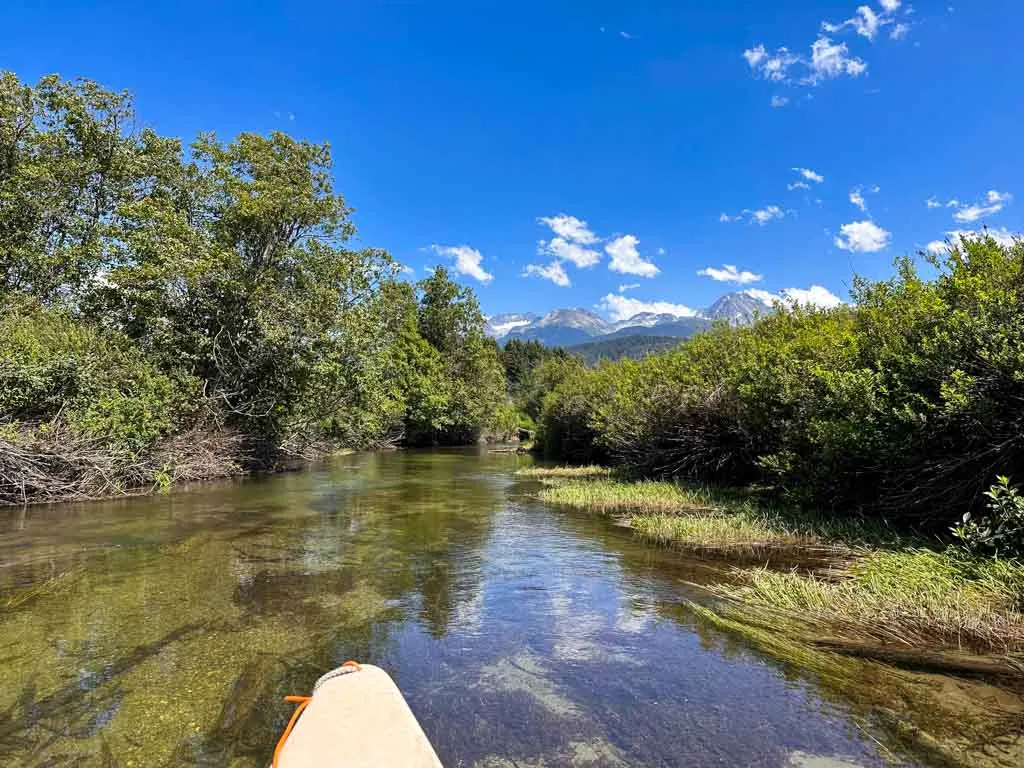
What to Bring on the River of Golden Dreams
If you rent a boat or go on a tour, they will supply essential safety gear including a PFD (life jacket), paddle, and bailer. They will also give you access to a cart to make portaging your boat easier. Here’s everything else you should bring on the River of Golden Dreams:
- Water shoes or sandals: Your feet will get when you are getting in and out of the boat. You may also have to portage your canoe, which means lifting it in and out of the water. Or you might need to pull or push your canoe through low-water sections. Bring water shoes or secure sandals. Neoprene paddling booties or Teva-style sandals are best. Flip-flops are a disaster since they fall off. Crocs can also be ok as long as you wear the heel strap. In a pinch, a pair of old running shoes will also work.
- Quick-drying clothing: You might get a little wet, so wear quick-drying clothing. If you wear pants, make sure you can roll them up to your knees.
- Light jacket: The weather can change quickly and you’ll be out for a few hours. Pack a fleece or a light rain jacket in case it gets cold or starts to rain.
- Sunscreen: It’s bright out there and the sun reflects off the water. Slather on sunscreen before you go and bring the tube along to reapply halfway through.
- Hat: Shade your face from the sun!
- Sunglasses: The glare off the water can be harsh. Bring polarizing sunglasses. Goodr makes my favourite budget-priced (yet durable) polarized sunnies. I also use a Neoprene strap to keep my sunglasses secure when paddling. You don’t want to drop them into the water!
- Water: You’ll be exercising in the sun and you need to stay hydrated. Pack at least 1L per person. I like to bring my Hydroflask since it keeps my water cold.
- Snacks: Bring some snacks in case you get hungry. I recommend picking up a treat from Purebread to enjoy along the way.
- Dry bag: Bring a roll-top dry bag to store your snacks, extra clothing, and essentials that you don’t want to get wet. Sea to Summit makes my favourite lightweight dry bags.
- Phone leash: This one is optional, but is a game-changer for me. I use this simple phone leash to tether my phone to my life jacket or shorts. That way it’s easy to grab for photos, I’m not worried about dropping it in the river!
- Canoe cart: If you have your own boat, portaging is much easier with a canoe cart. (We use this canoe cart.) The portage trail is flat and part paved and part gravel, so it’s the ideal scenario for a cart. If you don’t have a cart, it’s also fairly easy to carry your canoe if you are an experienced portager.
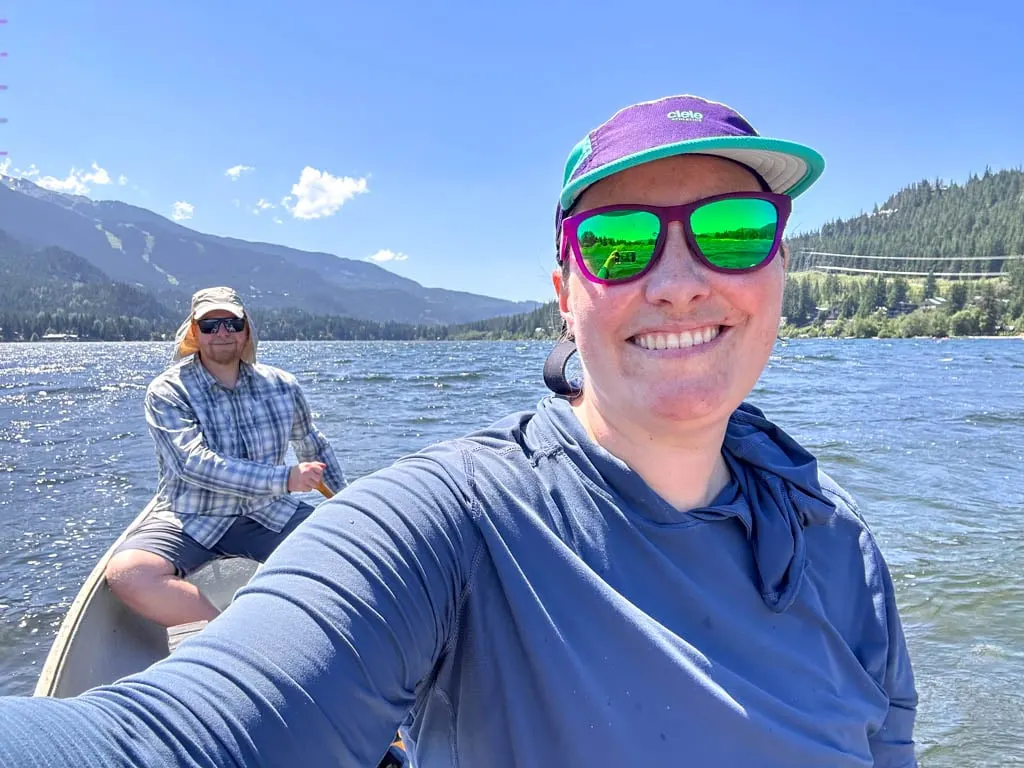
Paddling the River of Golden Dreams is one of my favourite things to do in Whistler in the summer. It’s such a fun way to enjoy the valley away from the hustle of the village. If you have questions about the trip, let me know in the comments.
READ NEXT:
- Visiting Whistler, BC in Summer (By a Local)
- 80+ Things to Do in Whistler (By a Local)
- 42 Cheap and Free Things to Do in Whistler
- The Best Hikes in Whistler
- Camping in Whistler, BC
- Sea to Sky Highway Road Trip Guide: Driving from Vancouver to Whistler
- My Favourite Hiking Gear of 2025 - December 9, 2025
- Best Insulated Skirts For Hiking and Snowshoeing in 2026 - December 5, 2025
- Snow-Free Hikes in Vancouver: 50+ Year-round Trails - December 4, 2025

